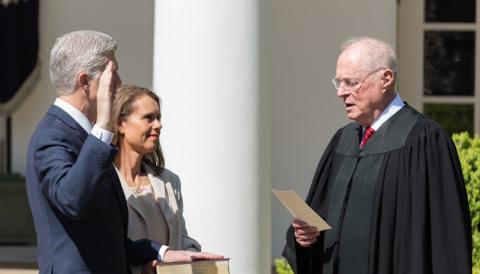I miss Anthony Kennedy already. Other people have written eloquently about Kennedy’s contributions to the Supreme Court. After the retirement of Sandra Day O’Connor (whom I miss, too), Kennedy became the swing vote in case after case.
When a seminal case was argued before the high court, Kennedy was the justice who had to be persuaded. When a 5-4 decision came down, Kennedy was usually that crucial fifth vote. Sometimes he voted with the more liberal wing of the court; sometimes he voted with the four conservatives.
Kennedy’s influence came from the fact that he was not ensconced in one ideological trench or the other. Members of the court who wanted to win his vote had to venture towards the ideological middle.
As we look back on the influential tenure of Justice Kennedy, let’s also look forward: Justice Kennedy’s legacy could help fix the legislative branch. If we had a few more Anthony Kennedys in Congress and our state legislatures, those institutions would function better.
Our strategy at Unite America is to elect those “Anthony Kennedys.” We even have a name for it: the fulcrum strategy. Why was Kennedy so influential on the Supreme Court? Because he sat in the ideological middle. Neither side could take his vote for granted. Just a handful of centrist legislators—leaders willing to stand apart from the two political tribes—could have the same impact.
Consider our narrowly divided U.S. Senate. If we were to elect just two or three centrist independents in 2020, we could easily end up with a Senate that splits 49 Republicans, 49 Democrats, and two Independents. The key is that neither party would have a majority. Who would wield the influence in that scenario? The two Independents.
Those two centrist Independents would effectively pick the Senate Majority Leader. As with Anthony Kennedy, the Senate “Centrist Caucus” could toss their support to the Democrats, or to the Republicans, depending on which party offered a more reasonable candidate for leader of the Senate.
Mitch McConnell? Absolutely not. Chuck Schumer? No better. Rather, our Centrist Caucus—acting like Anthony Kennedy—would encourage both sides to offer up a more palatable Majority Leader, say Susan Collins (R-ME). The Democrats might counter with Joe Manchin (WV) or Heidi Heitkamp (ND). The result with any of these leaders as Majority Leader would be a Senate that operates in a less partisan and more effective manner what we are seeing now.
Unite America is also taking the fulcrum strategy to the states, where many legislatures are as narrowly divided and partisan as Congress. In Maine, two Independents were elected to the state legislature in 2016. Since then, two Republican incumbents and two Democratic incumbents have left their parties, denying either party a majority. As the fulcrum strategy predicts, this Independent bloc has been able to work together on an array of issues, including drafting a proposal to overhaul the state's tax system that draws on the best ideas from both parties.
In Colorado, State Senator Cheri Jahn (I) worked with 18 Republicans and 16 Democrats to unanimously pass a transportation bill that addresses long-term infrastructure funding challenges. In Alaska, two Independents helped to create a bipartisan governing coalition. Yes, you read that correctly: parties governing together, inspired by a few Anthony Kennedy state legislators. Alaska recently passed an ethics bill sponsored by Rep. Jason Grenn (I).
Can you imagine that in Congress?
Meanwhile, the group No Labels has introduced a strategy similar to ours for the U.S. House of Representatives: the Speaker Project. No Labels is urging its bipartisan Problem Solvers Caucus to withhold their votes for the next Speaker unless that candidate receives some votes from the minority party and also agrees to a series of rules changes that would make the House a less partisan institution.
As the New York Times reported, “The idea would be to restore the role to its intended purpose of serving as leader of the whole House rather than the highly partisan and polarizing position it has become.”
There is one crucial difference between legislative bodies and the Supreme Court. The high court can function in the face of any ideological divide. The votes fall where they may, whether it is 5-4, 6-3, or 9-0. Whoever President Trump appoints, the Supreme Court will continue to do its business.
Legislatures are different. When the Republicans and Democrats dig deep ideological trenches, one of two things tends to happen. The first is paralysis. The two parties dig such deep ideological trenches that nothing gets done. There are no legislators in the center to bring to two sides together.
We’re seeing a lot of that in Washington. Congress has not produced a budget in years. We have no action on infrastructure, even though both parties claim to be in favor of it. The national debt is growing ominously. Roads and bridges are crumbling. The manifestations of climate change are becoming more severe.
The second possible outcome in the face of hyper-partisanship policies is that policies whipsaw back and forth, as control of the government changes hands. The Obama Administration passed the Affordable Care Act with no Republican votes. Not surprisingly, when the Republicans came back to power, they tried to get rid of it (or parts of it).
The Democrats passed reforms to regulate Wall Street more heavily. The Republicans are dismantling those regulatory changes. President Obama directed the EPA to regulate carbon emissions; President Trump is trying to stop that. And so on.
If and when the Democrats come back to power, they will undoubtedly try to undo what the Republicans have done. That is no way to run a country.
The alternative is the Anthony Kennedy model: stake out the middle ground and force the partisans to come to you. Use the power that comes from being the swing vote to force more moderate—and therefore more durable—outcomes. Justice Kennedy is retiring. The “fulcrum strategy” he inspired should live on.
